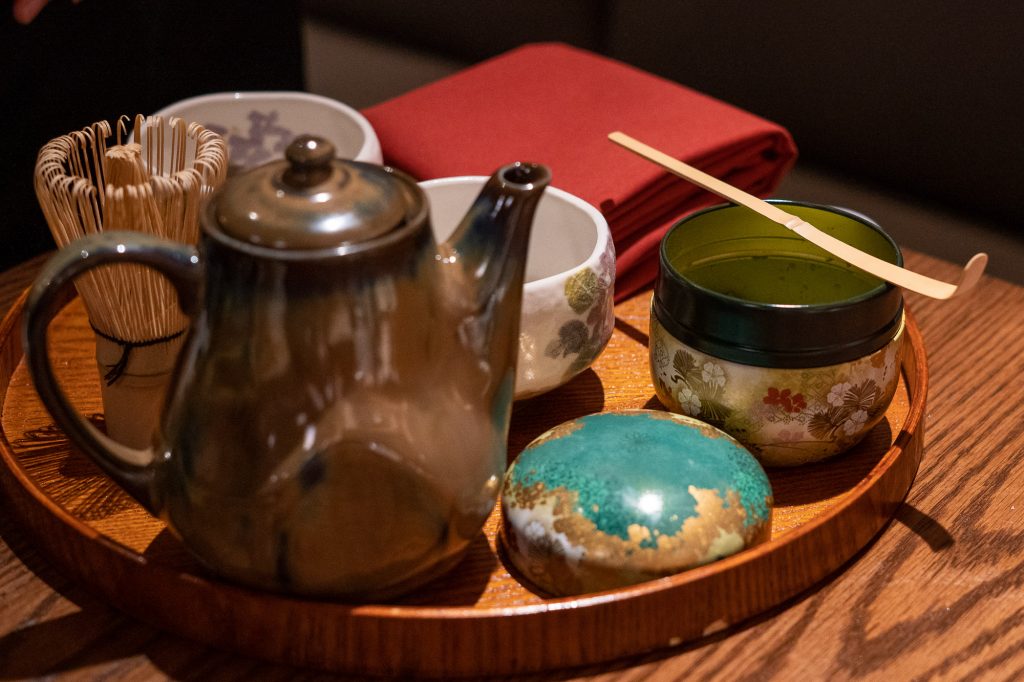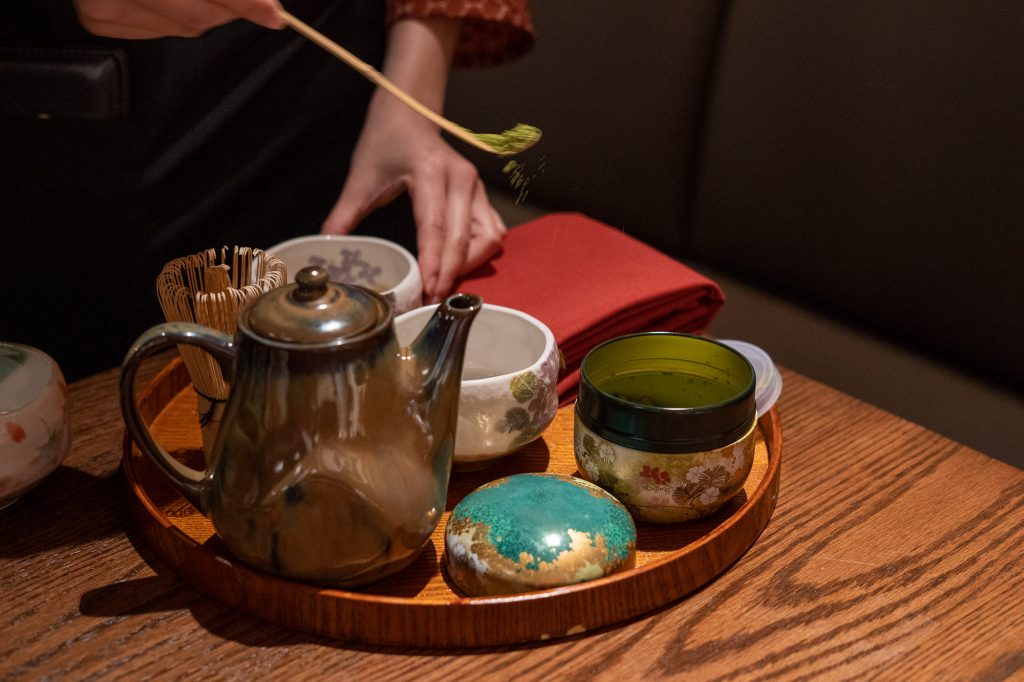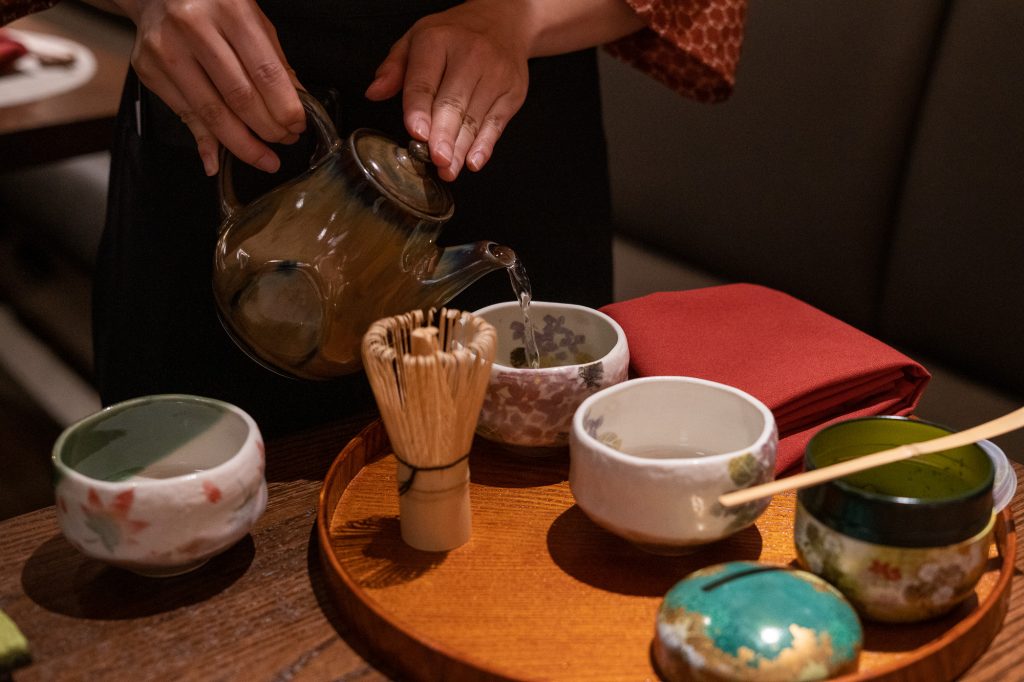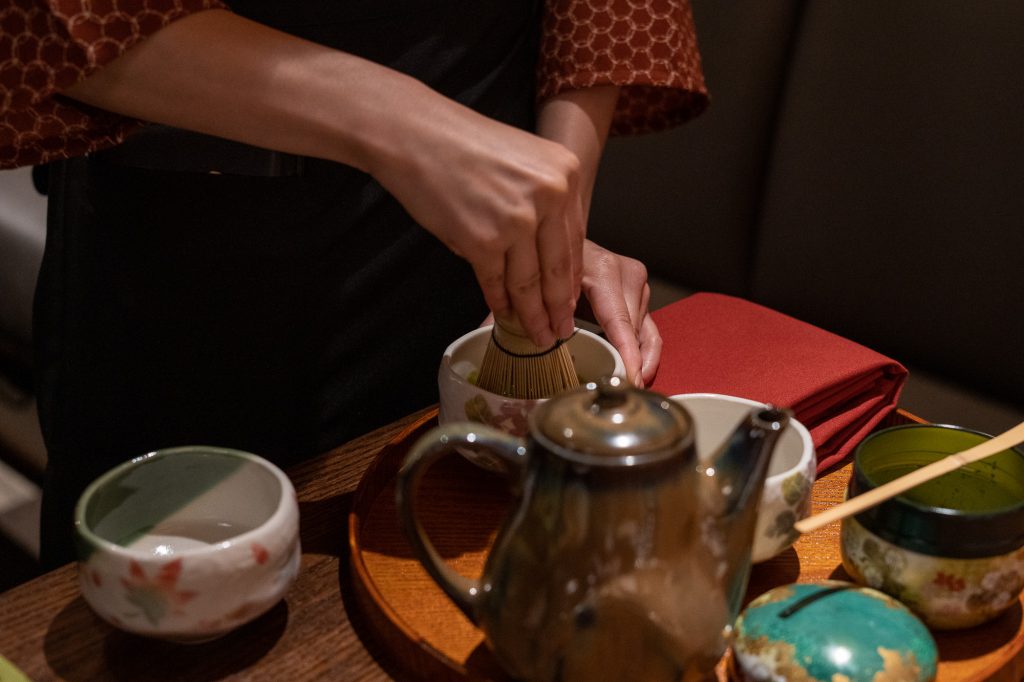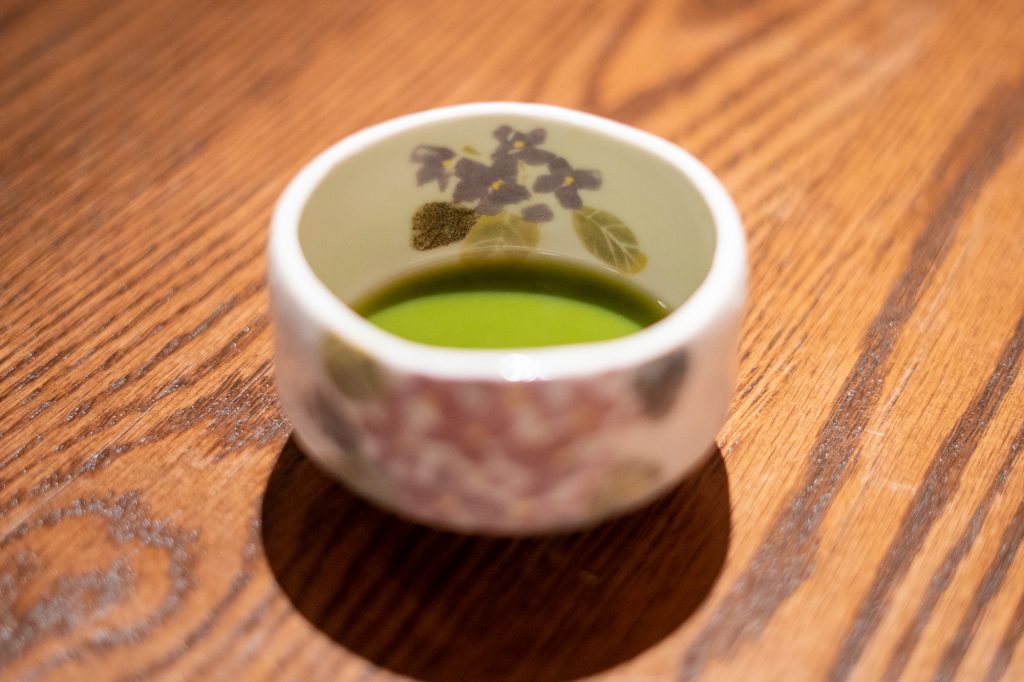Yesterday marked the opening day for Takumi-Tei, the new Signature Dining restaurant in the Japan Pavilion in Epcot. Announced in May 2018, Takumi-Tei is the seventh dining location run by Mitsukoshi USA at Walt Disney World. The entrance to the restaurant is really quite hidden, much more so than you might expect for the most expensive dining location in a Walt Disney World theme park. In our Takumi-Tei review, we’ll go over the entire dining experience, what you can expect from the menu, and if it’s worth adding such a premium experience to your next visit to Epcot.
Again, the entrance to this restaurant is off the beaten path. Located in a corner of the impressive Japan Pavilion, the restaurant almost seems like an afterthought from the outside. Throughout this review, we’re going to hold Takumi-Tei to a bit of a higher bar than we would for a typical table service restaurant. This is priced at a premium, and the experience should reflect that price.
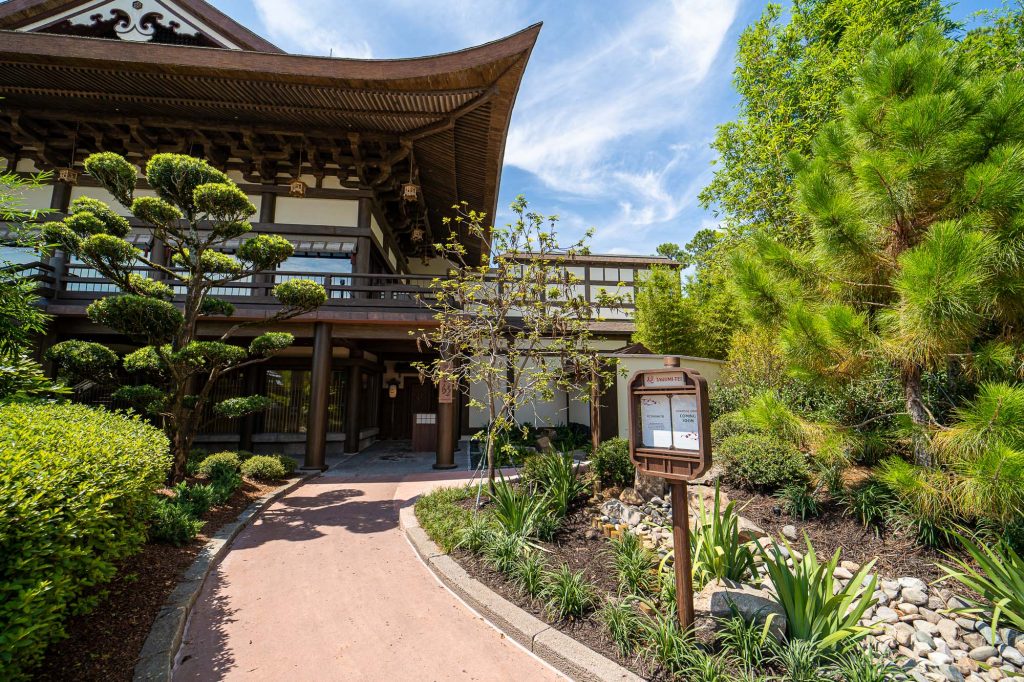
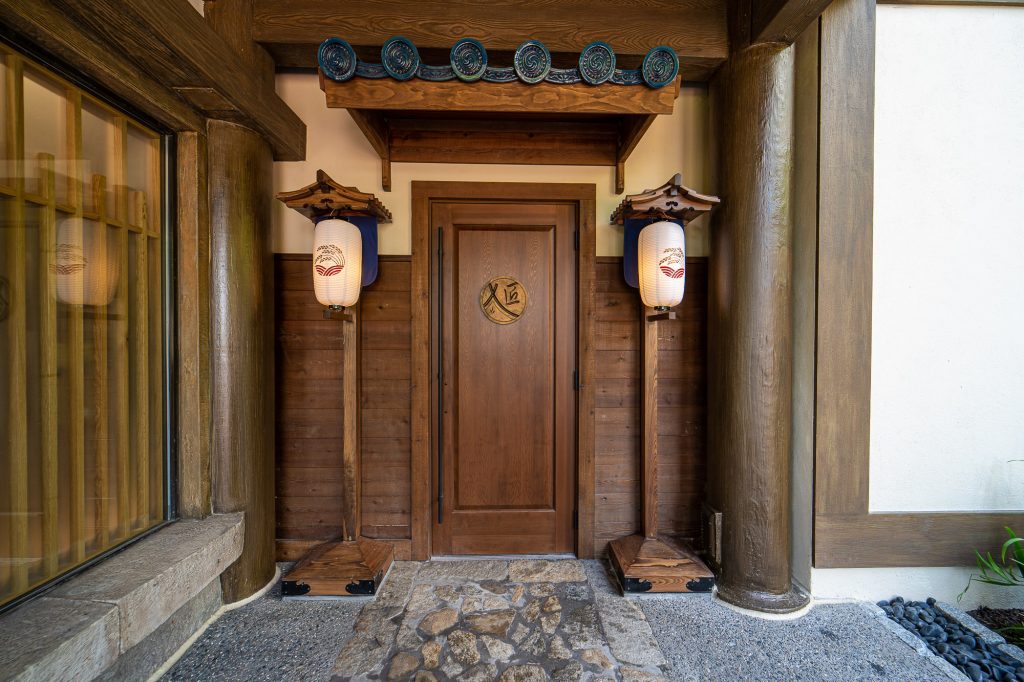
A quick note, we paid full price for our meal minus our Tables in Wonderland discount. As far as discounts are concerned, we’re quite happy to report that Annual Passholder, Disney Vacation Club, Cast Member, and Tables in Wonderland discounts are accepted on “regular menu items”. That means that discounts won’t extend to the Omakase Tasting Menu or Chef’s Dining Experience. Takumi-Tei does not participate in the Disney Dining Plan.
Ok, we’d normally take this time to comment on the theming, but we’ve already put out an article with a look around. We’ll comment on the theming as it makes sense, but we’d really like to talk about the experience because that’s what Disney is really selling here.
With the exterior being so unassuming, it’s worth noting that there isn’t a lot of waiting area. As is typical on unannounced opening dates, it wasn’t terribly busy, so standing around and waiting a few minutes to be called back to the podium to enter the restaurant wasn’t a big deal. However, we anticipate that there will be a certain amount of demand once word gets out. Disney will likely have to look at adding some more seating than just the single bench that exists now. Also, this area is quite exposed to the elements. Disney didn’t build any additional shelter beyond the existing overhang that functions as a second floor balcony for Teppan Edo upstairs. It might seem like a small complaint, but again, we’re going to hold Takumi-Tei to the standard that they are charging for. Similar signature dining locations within theme parks like Le Cellier Steakhouse, Monsieur Paul, and Tiffins have indoor waiting areas, even if they’re small.
Once you’re called to the podium, you’re greeted by a hostess that will take you inside. You immediately get a sense that this is a different dining experience once you step inside the hallway that comprises the five elements that play a part in the story of the restaurant. We noticed that only one party was walked into this hallway at a time. That’s because your hostess welcomes you to Takumi-Tei and begins to explain the elements and their importance to not only the restaurant, but Japanese culture. We got lucky here being the very first guests ever in the restaurant. It was an intimate experience without anyone else trying to leave the only entrance/exit. While the hostess can control the amount of guests entering at one time, guests can freely exit down this hallway and possibly interrupt your welcome experience.

Once introduced to the elements, you’ll be seated in one of five rooms. Well, one of four rooms in reality. The Water Room is reserved for the Chef’s Table Dining Experience. The Chef’s Table Dining Experience is reserved for parties of 6-8 guests and must be booked in advance. It’s a nice room and you can just barely see the door on the left side of the below photo that leads directly into the kitchen. A nine course meal will run you $180 per person.
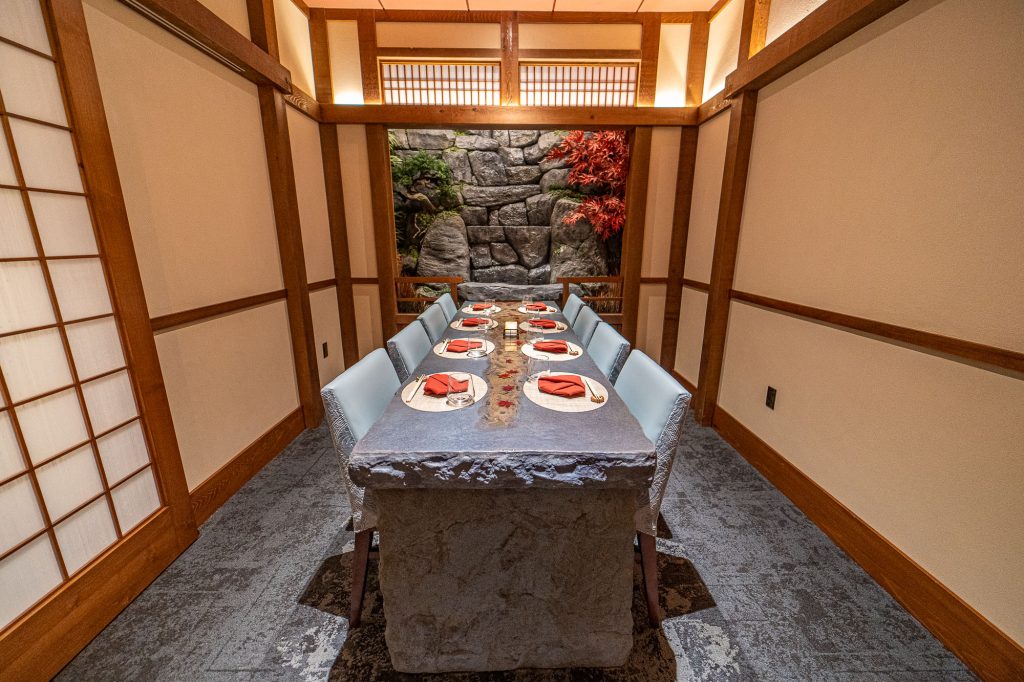
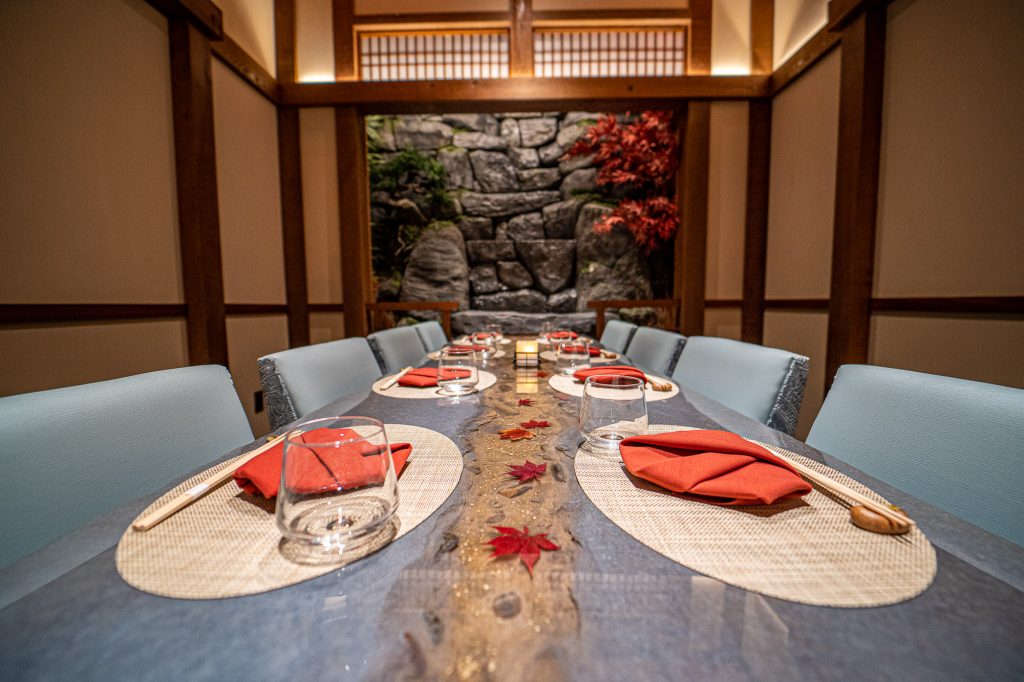
We were seated in the Wood Room, which featured warm wood tones, wood carvings, and wood art pieces. Out of all five rooms, the Wood Room probably sits at fourth place, if we were to rank them on immersion of theme.

The “least” themed room would probably be the stone room. It sits on the other side of the divider seen above in the Wood Room and features a rock wall and the restaurant bar. Other than that, it’s somewhat bare.


Third and second on our theming list would be the Earth Room and Paper Room, respectively.
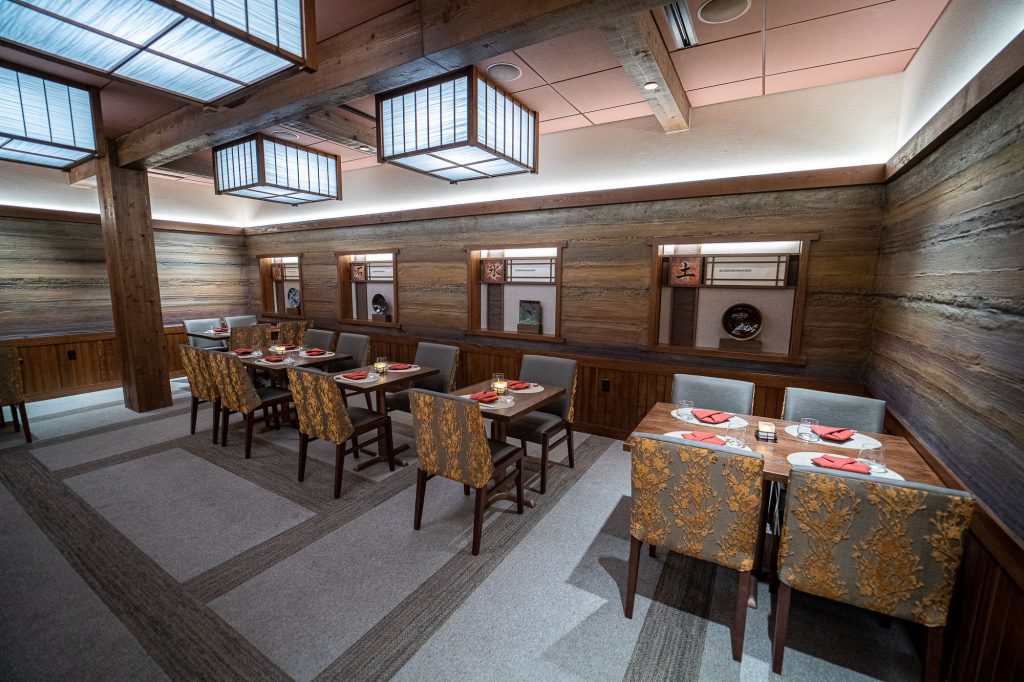
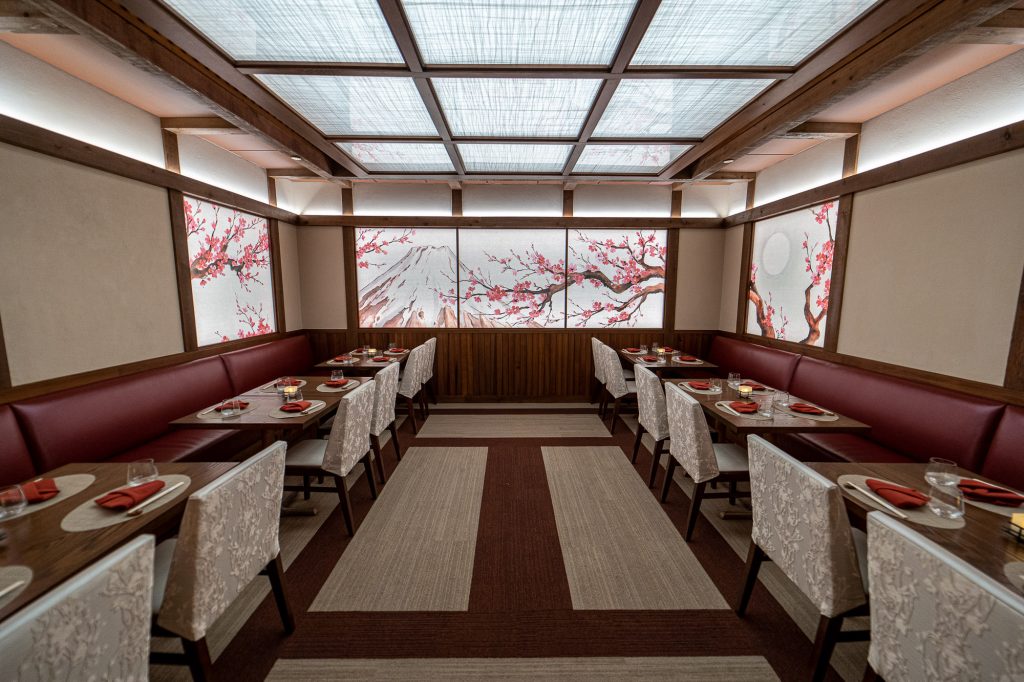
The Water Room would finish on the top of our list, if you can reserve it.
Before we jump into the menu, we’d like to talk about one more aspect of the dining experience that we’re sure you’ll have questions about – the dress code. Takumi-Tei is the second in-park restaurant to list a dress code on their website. Here’s what Disney defines as appropriate attire.
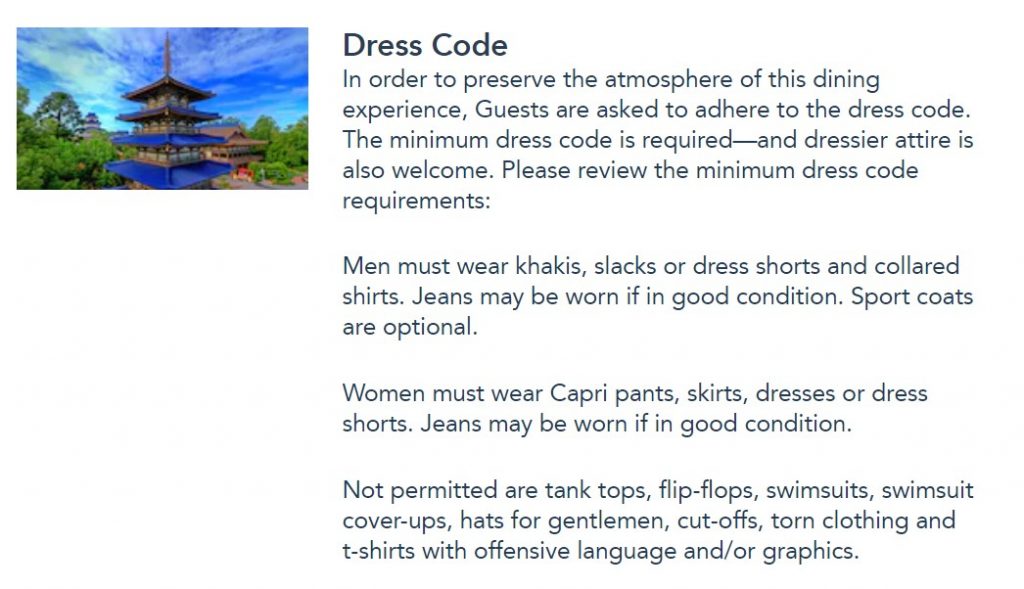
Let’s start with the “why”. Simply put, you’re spending a lot of money here. This isn’t a quick service or even a standard table service where you might reach $100 on your bill if you work through all three courses. At Takumi-Tei you’re talking $100’s of dollars for a party of two, which means that you probably want a higher scale dining experience than some guy in a tank top and flip-flops.
Of course, in practice, this breaks down a bit. You’re in a theme park after all, and not everyone can be expected to be in dressier attire all day until their 6pm dinner. Will they turn people away at the door for being in typical theme park attire? Maybe. Should you at least try and dress up a bit out of respect for your fellow diners and the atmosphere of the dining location? Probably. Is it ridiculous to have a dress code in a theme park restaurant? Yes.
We were the first guests seated when Takumi-Tei opened and we noticed at least two tables where the men didn’t have collared shirts during our nearly 3-hour dining experience. Did that ruin the experience for us? No, but we can certainly understand why a dress code is listed, given the upscale atmosphere that Disney is trying to create here.
In short, the dress code is going to be difficult for them to enforce simply from a logistical standpoint of their location within a theme park. They weren’t even able to enforce it for one hour, speaking candidly. If Takumi-Tei was located in a hotel, it would be much easier to enforce. That said, it would be appreciated by all if you’re able to work the minimum dress code into your visit to Takumi-Tei.
One last thing. We briefly mentioned that we had a 3-hour dining experience. We were a party of two, taking photos and talking casually with our servers and managers that wanted to hear our thoughts. This probably isn’t typical. That said, the Omakase Tasting Menu isn’t a quick, one-hour experience. Depending on the pace of your party, I’d plan for anywhere from 2 to 3 hours for your dining experience. It’s possible that you can dine in less than 2 hours, but that would require you to really push through the menu at too quick of a pace for the immersive experience and discussion that should take place for each dish. Talking with your server, who is a cultural representative of Japan, is part of the experience. Not only will they be excited to talk about the dishes and how they play into Japanese culture, but they’ll be able to answer any questions you might have (like what is the best way to get to the bone marrow in the Nikomi Wagyu). Take your time and enjoy. The Takumi-Tei dining experience will take you out of the “theme park” and immerse you in an authentic Japanese restaurant if you let it.
Omakase Tasting Menu
We opted for the Omakase Tasting Menu. It’s featured on the menu board outside and was highly suggested to us by our servers and managers we spoke with. Omakase, which means “I’ll leave it up to you”, takes the ordering process out of your hands and leaves the choices up to the chef, which translates to a seven-course tasting menu.
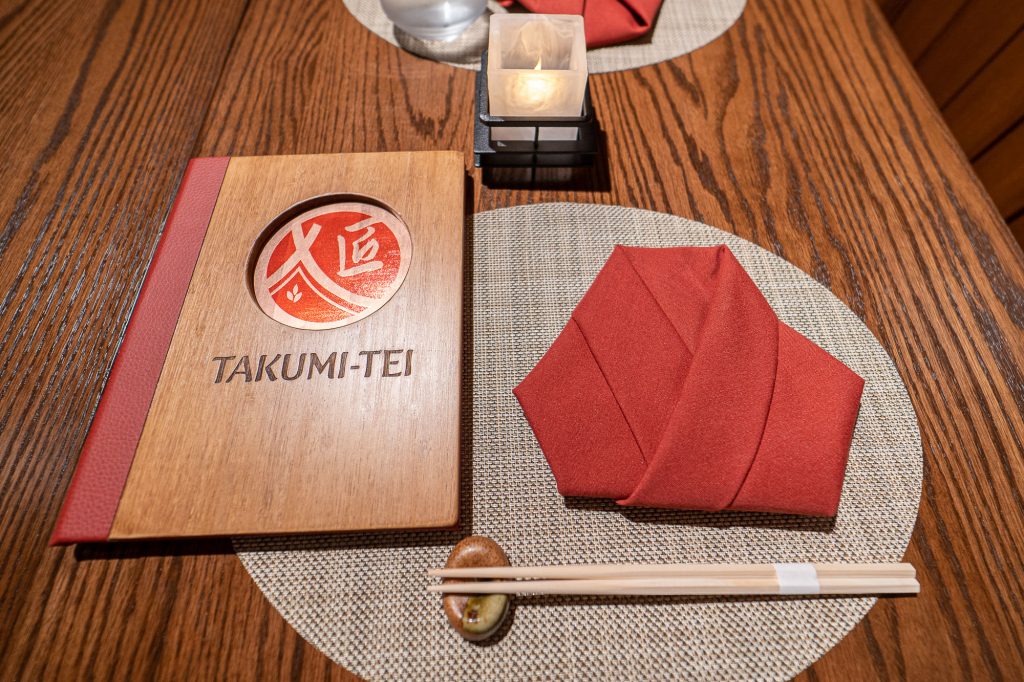
As for some of the logistics, the Omakase Tasting Menu is $130 and it can be shared between guests. Presentation and portions are set for a single guest to enjoy the tasting menu, so if you want to split the portions, just ask for a knife to split the dish.
We’ll get this out of the way early, this menu probably isn’t going to fill you up. If you want something heavy to fill up your stomach after a long day in Epcot, there are a lot of other dining options around World Showcase that would serve you better. This is something entirely different, and the price reflects that. There probably isn’t a single item on the menu that would suggest that this is simply somewhere to eat, it’s billed as more than that. Disney explains the experience as the following:
The entire Takumi-Tei experience is focused on giving you a better understanding of Japanese culture, as explained to you by the Japanese cultural representatives. From the moment you walk in to the moment you put down your chopsticks for the last time, you will feel as if you’ve been transported to the island nation and will learn about Japanese traditions and their connection to the natural world.
We started by ordering our drinks. These aren’t included in the Omakase Tasting Menu, but are still very thoughtfully crafted and worth a consideration. Each of the specialty cocktails represents a room inside Takumi-Tei. Here’s a rundown of the specialty cocktails and what we ordered.
Kochi (Earth) – Joto Yuzu Citrus Sake, Rum, Fresh Mint, Yuzu Juice, Orange
Unkai (Water) – Midorikawa Green River Junmai Sake, Singani 63 Spanish Brandy, Taylor Velvet Falernum, Green Tea-Infused Foam
Raiju (Stone) – Haku Japanese Vodka, Spiced Ginger Beer, Lime
Sakurajima (Wood) – Kaiyo Japanese Whisky Sour with Smoked Cherrywood
Kami (Paper) – Roku Gin, Sayuri “White Lilly” Nigori Sake, Calipco, Lychee
All of the signature cocktails will run you $15, and they are covered by any discounts that apply to alcohol. We tried the Sakurajima and Kami. We couldn’t have been more pleased with our drinks. We spoke with a manager who said that these were probably the two highest rated drinks during their test and adjust meals.
The presentation was wonderful for both of the drinks, with the Sakurajima arriving in a smoke box. Inside, the drink sits in the Cherrywood smoke until it’s delivered to the table. We last saw something like this with the Temple of Bacon at Jock Lindsey’s Hanger Bar and we’re fans of this presentation! When opened, the Cherrywood smoke fills the air, giving off a wonderful aroma that you might find over in the incense section of the Mitsukoshi gift shop next door.
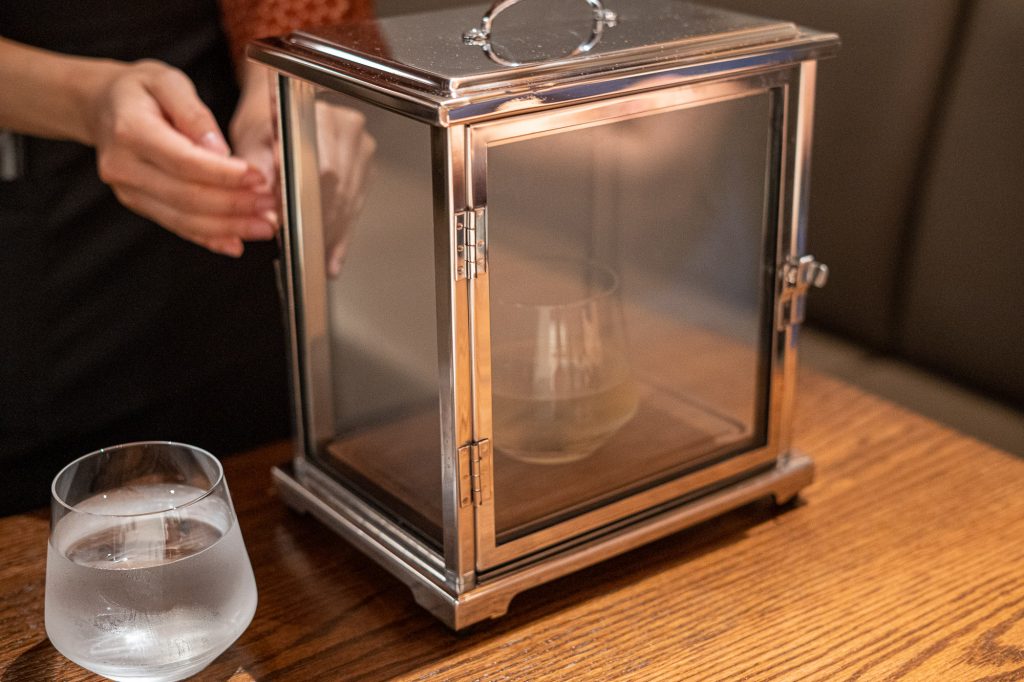
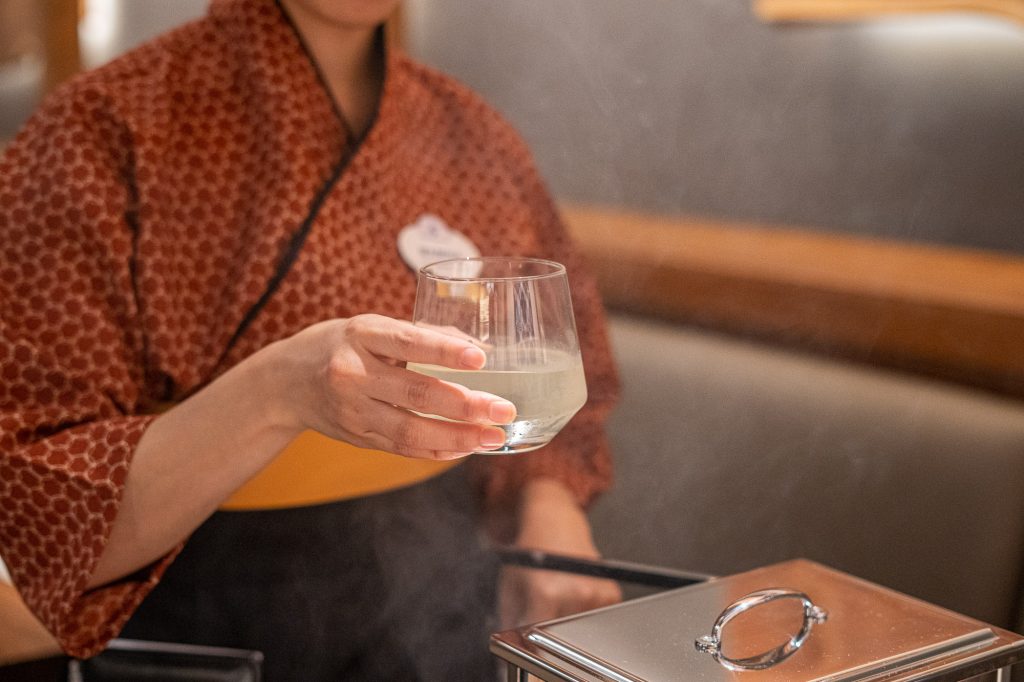
The excellent presentation doesn’t end there though. Inside the glass, whisky stones are used to keep your drink cool. While debating the usefulness of whisky stones is out of our depth, they are unique and they did keep the drink cool for a while. The best part, of course, is that there is no watering down of your drink like you would get with ice cubes. Between the presentation in a smoke box and the use of whisky cubes, this is a premium experience, as promised when you step in the front door of Takumi-Tei.

As for the drink itself, the Kaiyo Japanese Whisky makes the voyage from Osaka, Japan across the sea in a Japanese Mizunara oak cask, to your table. It’s a smooth whisky with any of the sour perhaps lost to the smoked cherrywood. It’s a good drink that probably ends up being a bit more strong than most.
Next up was the Kami. Again, the presentation here was unique, separating the drink from any ice that would water it down. The drink stayed chilled and then cool throughout the meal.
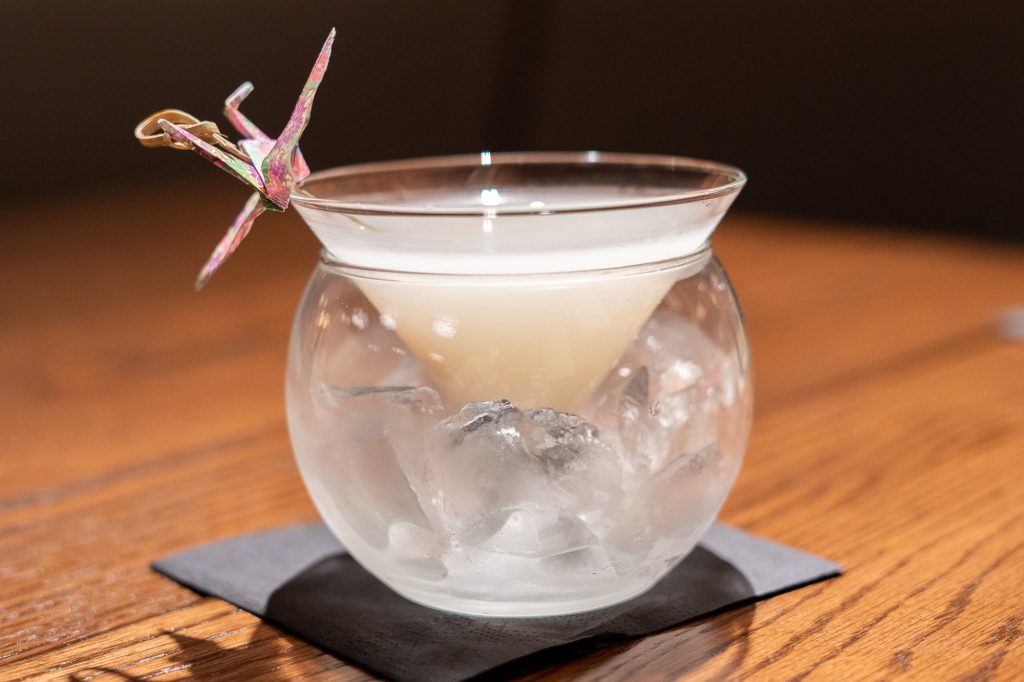
We asked for a sweet drink and the Kami was recommended to us. It’s certainly sweet and while the Gin is present, it’s nowhere near as strong as the Sakurajima. Both were really good and we can recommend them for your visit to Takumi-Tei.
Our Omakase Tasting Menu begins with otoshi, which is a traditional “first bite” served at Japanese restaurants. Otoshi is typically served as a means of providing a quick bite for guests between when an order is placed and when your food arrives. Intended as a gesture of hospitality, otoshi may have lost its stature in Japanese culture with some diners simply looking at it as an unavoidable upcharge in certain restaurants. At Takumi-Tei it’s viewed positively though, and what is served to you is up to the chef. There are some items throughout the Omakase Tasting Menu that will rotate on a daily basis depending on what chef you might have and what they can create on any given day. For this reason, it’s tough to review from the traditional standpoint, but we enjoyed the mushrooms that were offered as otoshi. Having daily rotating items plays perfectly into the concept of Omakase, and is a unique experience.

The next course is a sushi course called Temari Sushi. Again, there is no set menu on what pieces you’ll get here, with the menu calling for a “chef-selected assortment of oceanic delicacies”.
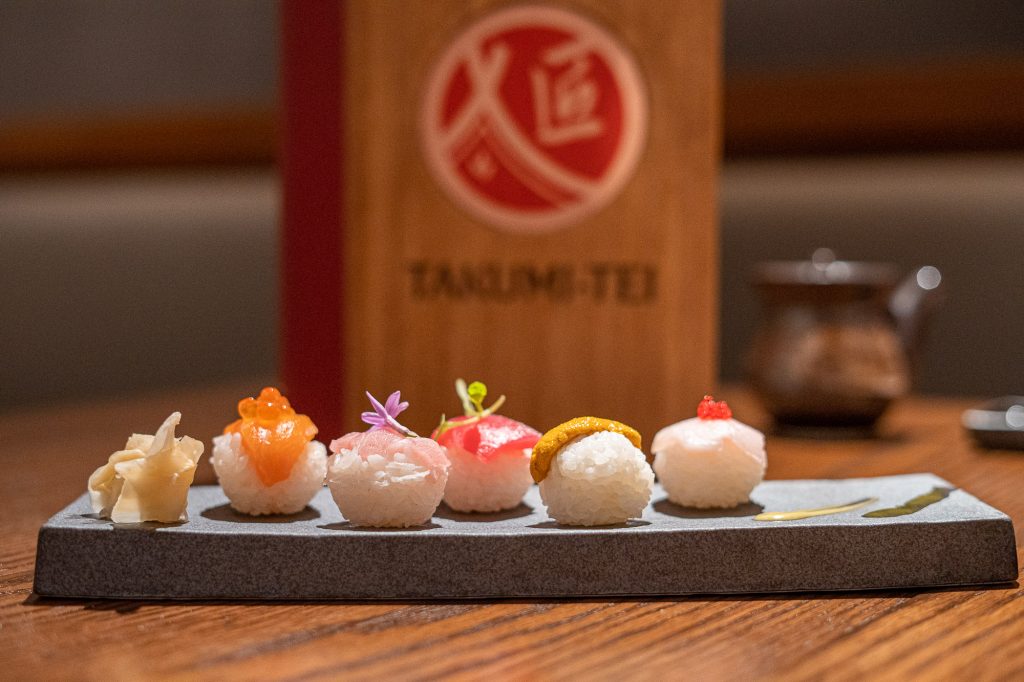
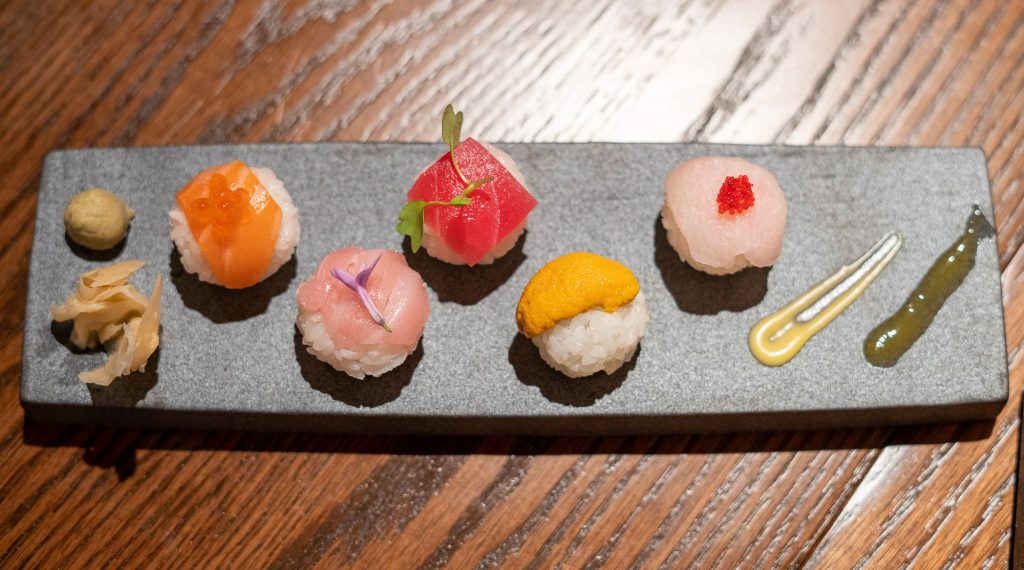
In our case, we received Tuna, Toro, Salmon, Sea Urchin, and Yellow Tail. It was described to us that this will change daily, just like the otoshi. From a practical standpoint, we assume that a portion of the fish might rotate, but that you’ll be able to see some overlap in the coming weeks as the kitchen works through their supply of fish.
The presentation of the sushi is wonderful, especially for a tasting menu. Again, dining at Takumi-Tei is about immersing yourself in Japanese culture. Having a cultural representative as you server means that you’ll learn more than meets the eye. For example, Temari Sushi refers to the shape of the sushi. Temari means hand ball, and it’s a traditional embroidered ball that people used to play with in Japan. Temari sushi got their name from the shape and colors that resemble the traditional balls.
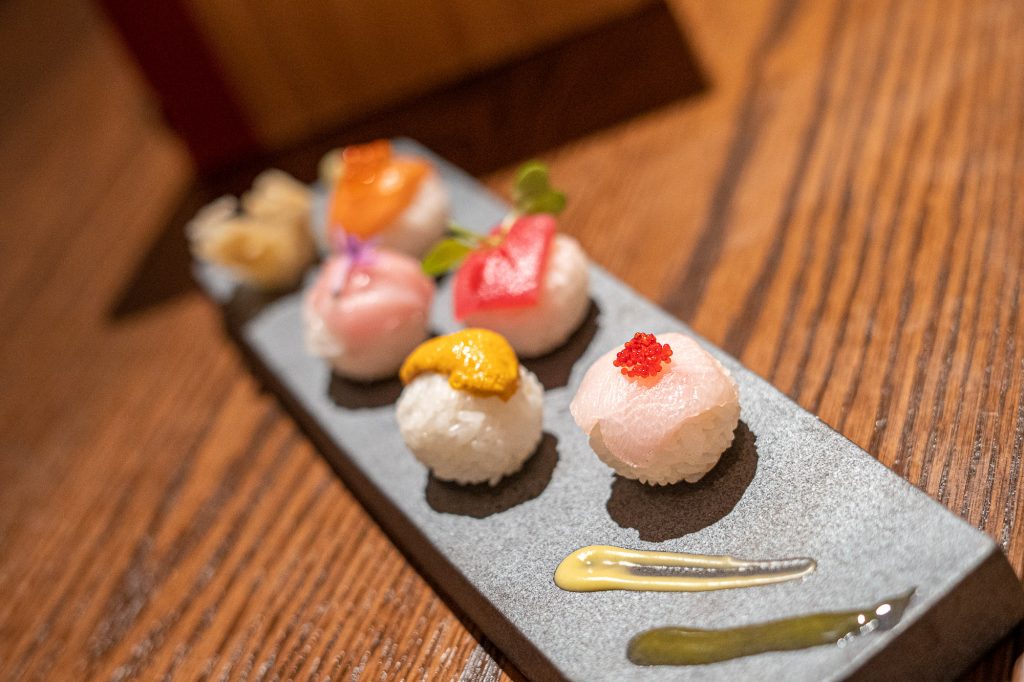
Our third course is Nikomi Wagyu, which is Roasted Bone Marrow, Braised Jackman Farms Wagyu Shortrib, Yuzu Kosho, Wasabi Shiso Bavaroise, and Warishita. Finally, we arrive at a set ingredient course. Outside of the Omakase Tasting Menu, this is offered as an appetizer for $27.

This is your first encounter with wagyu on the tasting menu. Sourced from Jackman Farms in Clewiston, Florida, this wagyu is American Kobe beef that is completely hormone free and antibiotic free. As for the beef itself, it’s incredibly soft and coats the palate with a bit of fattiness. The short rib sits atop a an archway of bone, with the bone marrow exposed once you get through the beef on top.
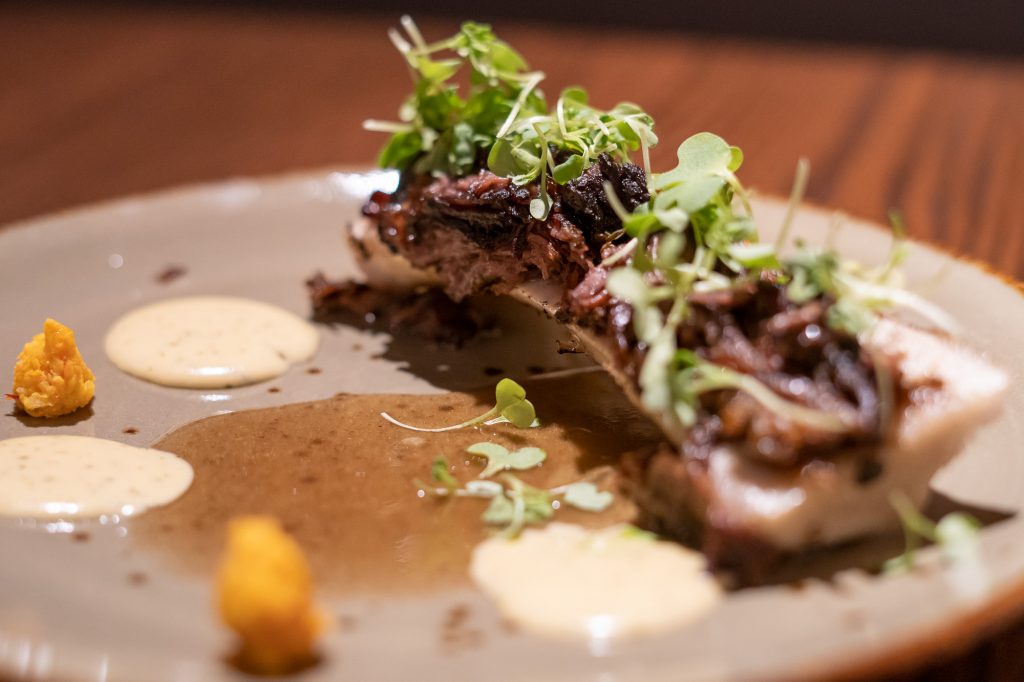

A tour of the plate will discover a pool of warishita beneath the bone, a wasabi shiso bavaroise that tastes like a bearnaise sauce, and a Yuzu Kosho that adds a nice citrus flavoring. All work together to create a robust dish that will take you on an adventure of flavors. It’s a delicious dish that we’d enjoy again.
The next course is a Hashiyasume, which acts as a palate cleansing course. This is a sorbet of sorts that is heavy on saltiness, while including cucumber jelly and ginger. All of the fattiness that might have coated your mouth from the Nikomi Wagyu above will disappear with just a “bite” of the Hashiyasume. We’d recommend not even taking a sip of your drink before the next course comes out. The palate cleanser is perfect, if not a bit harsh on the taste buds.

Finally, we have arrived at the fifth course, which will be considered the main course. The Wagyu Tabekurabe features Japanese A5 Wagyu Strip Steak paired with Jackman Farms Wagyu Strip Steak, Roast Cippolini Onion, Curried Potato, Seasonal Mushroom, Yuzu Kosho, Fresh Grated Wasabi, and Arima Sansho Pepper Reduction.
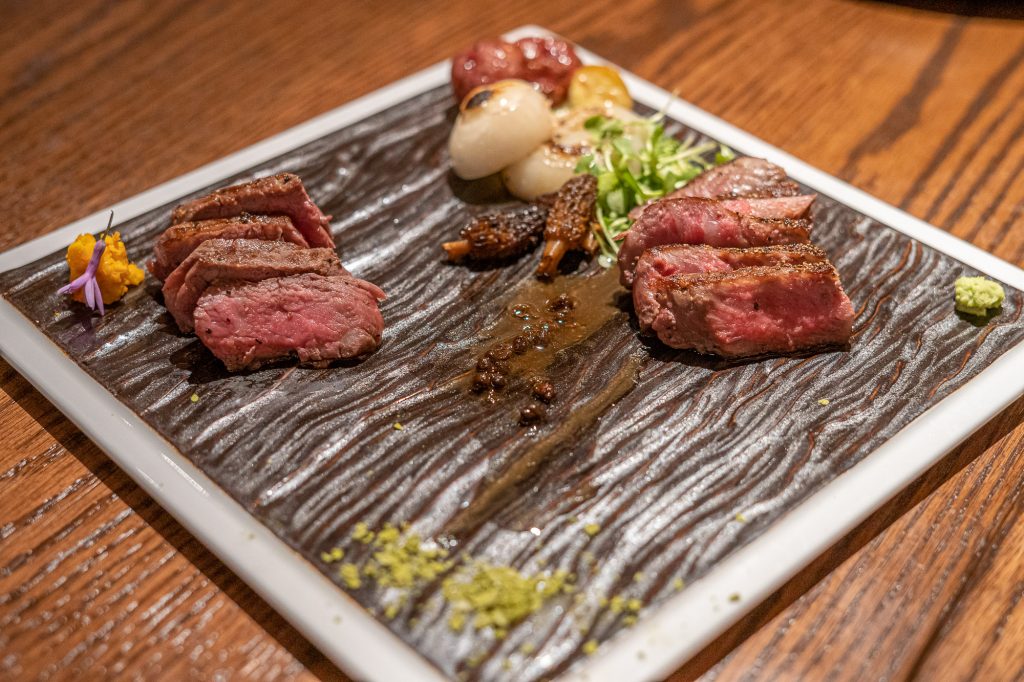
As seen above, the American wagyu is on the left, and the Japanese wagyu is on the right. Both are 2oz. We were asked a couple of times which version was better, and there is really no competition. The Japanese wagyu was absolutely delicious, with a slight sear on the edge that provided a bit of crunch against the soft meat. You can see the sear on the right in the photo below.

We see the return of the Jackman Farms wagyu in this dish. We last saw it in shortrib form in the bone marrow dish above. Compared the the Japanese wagyu, it’s just ok.
We’ll take a slight sidebar here to discuss the pricetag. If you want to get an A5 wagyu tenderloin, you can get it on the regular menu for $93. The servers and managers made it known that you can only get the A5 wagyu strip steak on the Omakase Tasting Menu. That said, you’re able to upgrade any of the Jackman Farms wagyu options to the Japanese A5 wagyu for about $30, depending on the cut. That means that you could technically upgrade the Jackman Farms Strip Steak to Japanese A5 wagyu strip steak for an additional cost if you’d like. Either way you approach it, A5 wagyu is going to cost you over $100 for 4oz of steak, either on the tasting menu or the a la carte menu.
I don’t think that the discussion here is value. Takumi-Tei is more about the experience than the value. That said, the beef was delicious. Would we love to see the option to substitute the Jackman Farms wagyu for more of the Japanese A5 wagyu? Absolutely. Especially given the fact that we’ve already encountered the Jackman Farms in the shortrib. Placing the Jackman Farms wagyu on the plate with the Japanese A5 wagyu cheapens the dish.
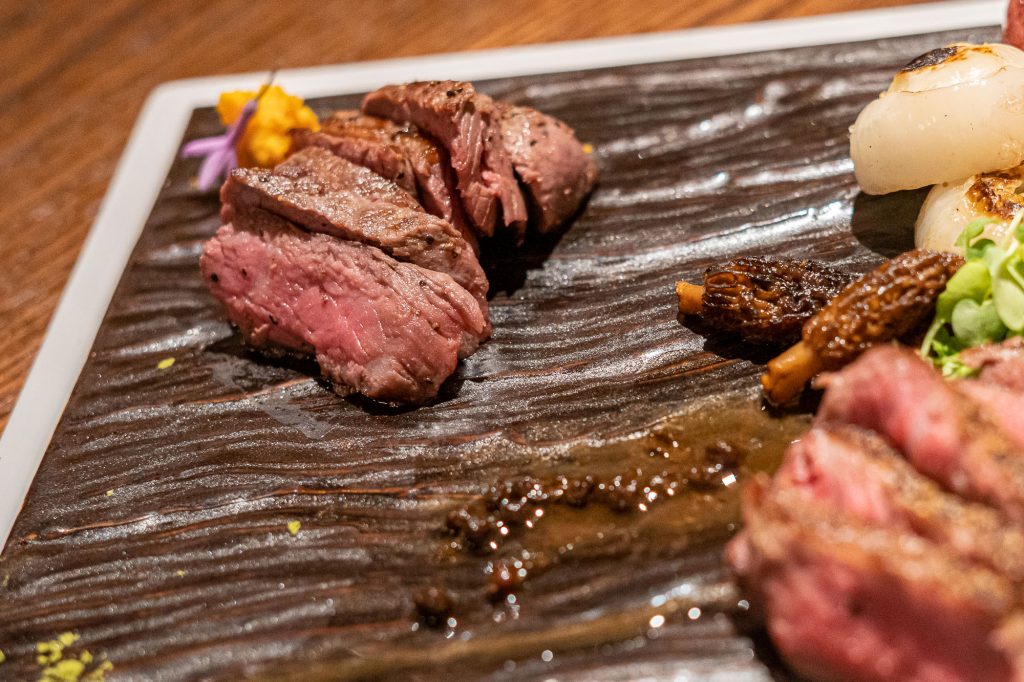
One other standout on the Wagyu Tabekurabe course is the wasabi. More accurately, the fresh grated wasabi. This is much more mild than traditional wasabi. So much so that we’d highly recommend adding some to at least one bite of the wagyu (probably the Jackman Farms wagyu).
Next up is the dessert course, Suiren Dani. On the plate you’ll find a Japanese Water Cake, rose, kuromitsu, and kinako crumb. This was the greatest disappointment of the tasting menu. As you might assume from the name, it’s simply a glob of flavorless water…literally. The only good part of this dish is the kinako crumb, which is a soy bean powder. When paired with the water, it almost turned into a mud of sorts, making the dish salvageable. However, I’m sure “salvageable” isn’t what Disney is going for here. We were told by managers that they expect to expand the dessert offerings in the coming weeks, and it can’t come soon enough.
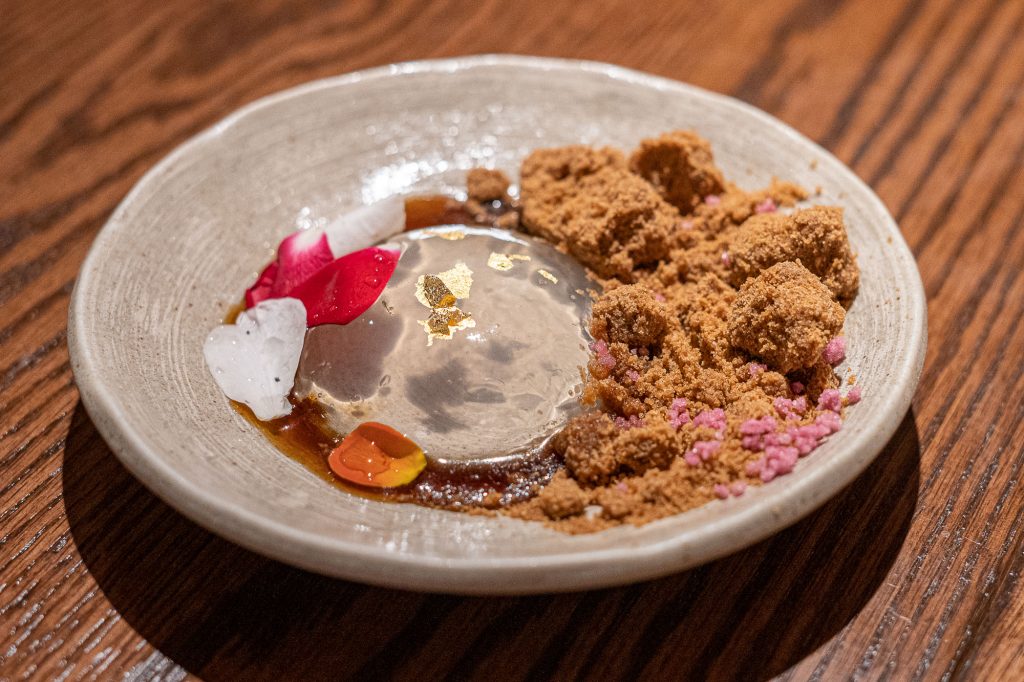
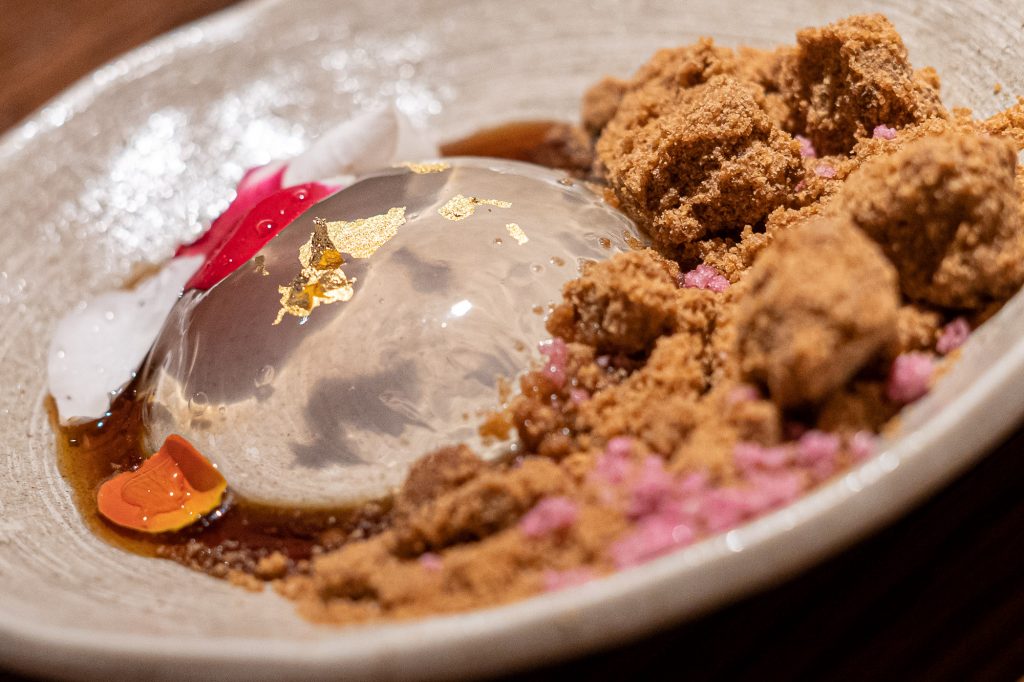
There is only one other dessert on the menu, so we decided to spend the extra $14 to secure the Kumo. Kumo is a Yuzu Cheesecake, Spiced Kabocha, Candied Yuzu, Orange Yuzu Gel, and Blackberry Sake.
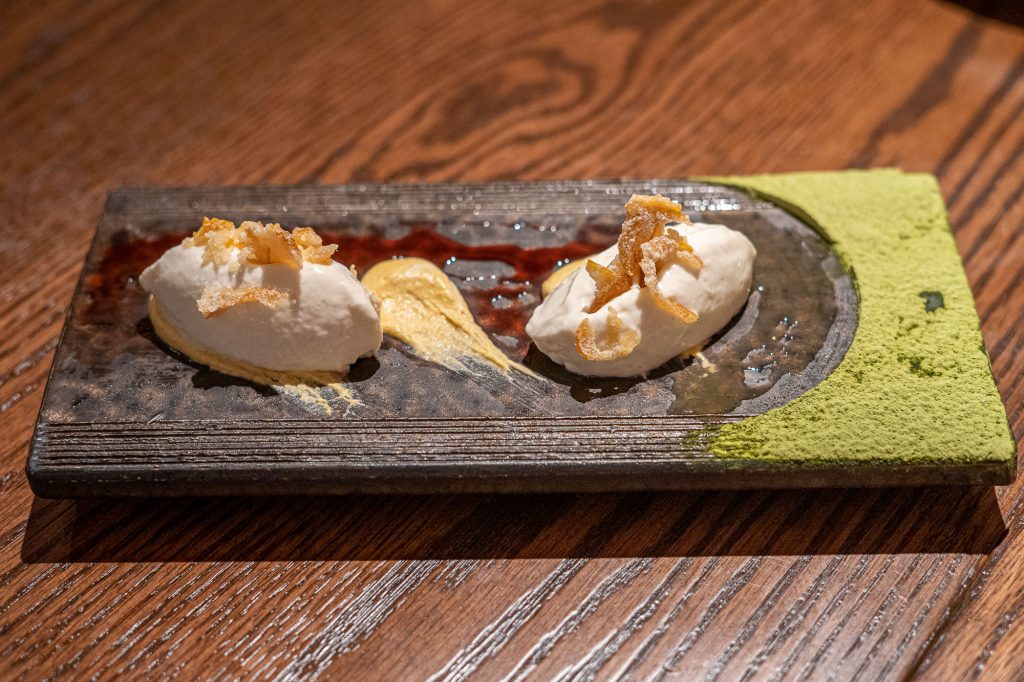
This was delicious! Given that it’s actually $2 less than the Japanese Water Cake on the a la carte menu, we’d like to see the option to substitute this dessert into the tasting menu. It’s full of flavor, with a rich cheesecake taste permeating throughout. We really enjoyed the Orange Yuzu Gel and Blackberry Sake in addition to the already flavorful cheesecake.
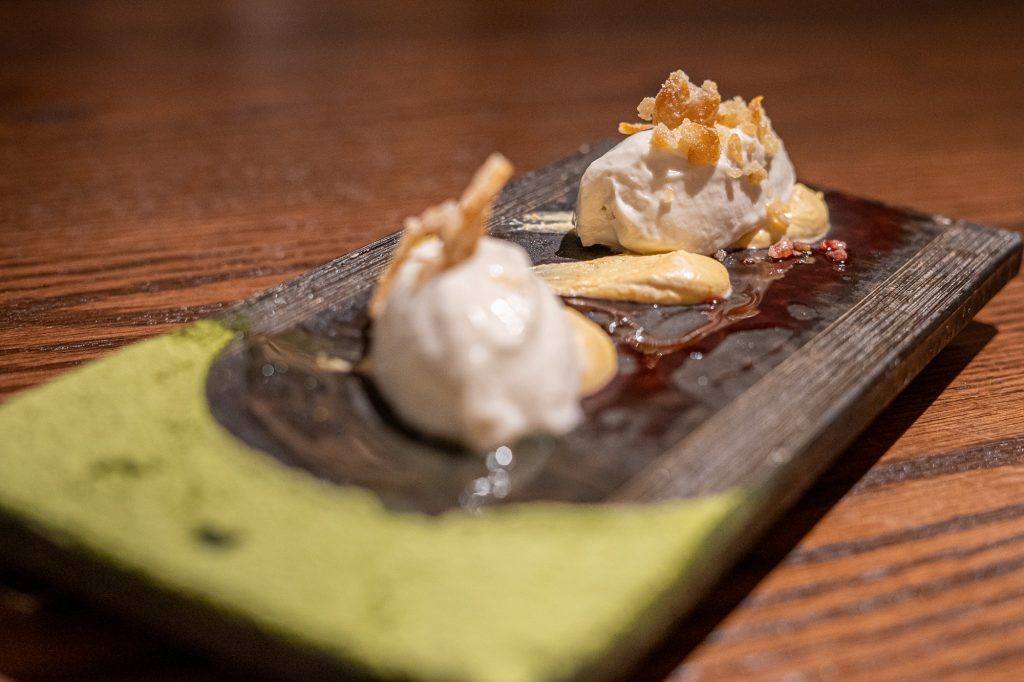
Finally, we have arrived at the final course of the Omakase Tasting Menu, the Tea Ceremony. What we get here is an abridged tea ceremony, as many of the traditional steps (over 1,000 steps!) wouldn’t make sense in a table service setting. I have to say, this was my favorite portion of the meal. It’s something quite special and the cultural representatives who perform the ceremony do so with pride.
The 2 minute ceremony is performed in the spirit of ichi-go ichi-e, which is a concept which means, “this moment is once in a lifetime so treasure it and cherish it by treating our guests with the highest respect”. It’s a beautiful ceremony and something that is a unique ending to what is a wonderfully immersive and welcoming experience.
We took a video of the Tea Ceremony that you can see below.
While that concludes the Omakase Tasting Menu, we want to offer a few more thoughts before concluding the review.
We’ll start with the atmosphere of the experience. One of the things that was present throughout the entire experience was the Japanese culture of welcoming hospitality. Every single Cast Member that we interacted with was extremely welcoming and kind. This is intrinsic to Japanese culture and is intrinsic to Takumi-Tei. Every course is served with a bow, every question is answered with a smile, and every interaction is so authentic to what we’ve experienced in our travels to Japan. Disney has an immensely valuable asset here with the cultural representatives in World Showcase. We’re happy to see that an entire dining experience has been crafted around the experiences and culture that these representatives are able to share with guests at Epcot.
The next thing we’d like to answer is who, exactly, this dining experience is for. Of course, anyone and everyone is welcome. Given the price though, this experience is much more appropriate for a special night out than a dinner on a whim. Managers we spoke with ranked Takumi-Tei as second only behind Victoria & Albert’s. They said that they are filling a large grey area between the AAA Five Diamond Award recipient, and something like Monsieur Paul.
You’re going to have to carve out 2+ hours for the Omakase Tasting menu. It’s for that reason that we think it’s likely that energetic young children won’t enjoy this experience as much as older children, or adults might. It’s also interesting how this dining experience is billed as more of a “once in a lifetime” dinner than a “we’re hungry, let’s go eat” dinner. We’re not going to rush to return to the Omakase Tasting Menu now that we’ve done it once, but we’d gladly sit down for a cocktail and tour of the sushi options on a return visit. If you’re planning a special night out at Walt Disney World, put Takumi-Tei in your top 3.
Finally, the price. It’s expensive. There’s no way around that. You’re paying for more than just the food that is put in front of you though, and for a special night out, we dare say that the $130 was “worth it”. There are other options on the menu besides the Omakase Tasting Menu, but we anticipate that this will be the most popular once word gets out.
One thing to note that we talked about earlier was discounts. Here’s a breakdown of what’s available:
- Annual Passholder – 10% off
- Disney Vacation Club – 10% off
- Tables in Wonderland – 20% off
- Cast Member – 20% off
While we were told that those discounts don’t apply to the Omakase Tasting Menu, our final bill did reflect a 20% Tables in Wonderland discount on the tasting menu and our drinks. According to managers, Takumi-Tei will not accept the Disney Dining Plan.
Logistically, reservations start July 16th, but walk-ups are currently being accepted. To make reservations for the Chef’s Table Dining Experience, call Mitsukoshi directly at (407) 827-8504.
When taking everything that we’ve had to say so far into account, we can definitely recommend Takumi-Tei. It’s a unique experience for a theme park and fits in perfectly with the theme of World Showcase. You’re immersed in an unfamiliar culture, welcomed to the table, and asked to leave the theme park behind. It’s an unexpectedly wonderful addition to World Showcase that we hope will stay special for years to come.




